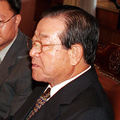South Korean legislative election, 2000
|
|
|||||||||||||||||||||||||||||||||||||||||||||||||
|---|---|---|---|---|---|---|---|---|---|---|---|---|---|---|---|---|---|---|---|---|---|---|---|---|---|---|---|---|---|---|---|---|---|---|---|---|---|---|---|---|---|---|---|---|---|---|---|---|---|
|
|||||||||||||||||||||||||||||||||||||||||||||||||
|
All 273 seats to the National Assembly of South Korea 137 seats needed for a majority |
|||||||||||||||||||||||||||||||||||||||||||||||||
| Turnout | 57.2% | ||||||||||||||||||||||||||||||||||||||||||||||||
|
|||||||||||||||||||||||||||||||||||||||||||||||||

■ GNP ■ MDP ■ ULD ■ DPP ■ NKPH ■ Others
|
|||||||||||||||||||||||||||||||||||||||||||||||||
Parliamentary elections were held in South Korea on 13 April 2000.
Many surveys showed that the Democrats would have more seats and votes, but the result was a victory for the Grand National Party, which won 133 of the 273 seats in the National Assembly. The United Liberal Democrats lost 2/3 of their seats, due to GNP's victory in Gyeongsangbuk-do, Gangwon-do (South Korea), and also fewer local votes in Chungcheong. However, the GNP did not receive a majority, so the 16th parliament became a Hung Parliament, and it was the only parliament in South Korean history — until the 2016 election — that the President's ruling party did not have a majority. So the Millennium Democrats, ULD and even Democratic People's Party (DPP) formed a coalition again to gain a majority, until the ULD withdrew support in 2001. The voter turnout was 57.2%. This election was the first election contested by the Democratic Labour Party, with no seats.
...
Wikipedia



